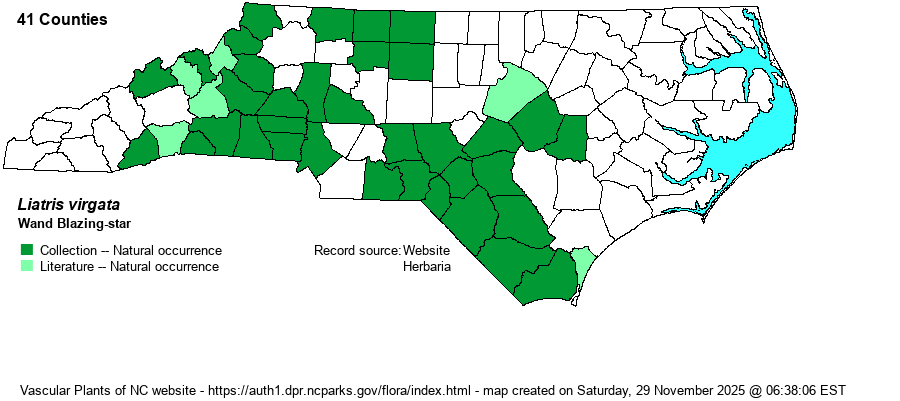| Author | Nuttall | |
| Distribution | Mountains, western and southern Piedmont, Sandhills (scarce), and southern Coastal Plain. Large gaps are hard to explain and may have to do with identification issues vs. Shaggy Blazing-star (L. pilosa), both of which were recently split out from L. graminifolia, which is no longer a valid name (according to Weakley 2018).
VA and WV to GA, primarily Piedmont and Coastal Plain. | |
| Abundance | Fairly common to common in the southwestern Coastal Plain, less numerous in the Sandhills; infrequent to fairly common in the western and southern Piedmont and parts of the northern and central Mountains. Seemingly absent from the northeastern Piedmont, the southwestern Mountains, and most of the eastern and northern Coastal Plain. Range and abundance are still somewhat unsettled. As an example of this, there are barely a handful of purported photos on iNaturalist, compared with many dozens of photos for the very similar L. pilosa. | |
| Habitat | An assortment of dry to mesic woodlands, rocky woodlands, openings, and roadsides; FNA also credits it to edges of swampy woods and stream margins, though in general it is an upland species of dry to mesic sunny or partly sunny places. | |
| Phenology | Flowering and fruiting August-October. | |
| Identification | The FNA website says it is "characterized by its non-congested arrangement of heads, often on a slightly zig-zag axis, and especially by its relatively thickened phyllaries [involucral bracts] with angled apices (acute to obtuse-apiculate)." Like Shaggy Blazing-star (L. pilosa), its lower leaves (at least) have eyelash-like hairs along the margins, but characters separating the two species in FNA and Weakley (2018) are conflicting in both keys! It is told from Sandhills Blazing-star (L. cokeri) by more florets per head (7-10 vs. 4-7), heads less densely arranged and not secund, and lower leaves 4-9 mm wide (vs. 2-5 mm wide). | |
| Taxonomic Comments | Formerly treated as L. regimontis, in part, or L. graminifolia, in part. More work is needed to satisfactorily separate it from Shaggy Blazing-star.
| |
| Other Common Name(s) | Grass-leaved Blazing-star (the name generally applied to the former L. graminifolia) | |
| State Rank | S4 | |
| Global Rank | GU [G5] | |
| State Status | | |
| US Status | | |
| USACE-agcp | | |
| USACE-emp | | |

